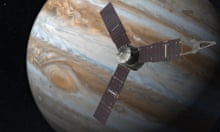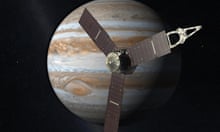After a five-year voyage across 1.8bn miles (2.8bn km), Nasa’s Juno spacecraft has reached Jupiter and successfully entered its orbit.
Braving intense radiation and a field of space rocks, the probe inched into the orbit of the largest planet in the solar system at 03.18 GMT.
The manoeuvre was extremely complex, with the craft first having to slow down and then turn off its engines to enter Jupiter’s orbit at exactly the right moment.
Juno’s success prompted joy at Nasa’s jet propulsion laboratory, where team members had been watching the probe’s progress with bated breath.
“Juno, welcome to Jupiter,” said mission control commentator Jennifer Delavan of Lockheed Martin, which built Juno. In the background, scientists could be seen cheering, clapping and hugging each other.
“You’re the best team ever! We just did the hardest thing Nasa has ever done,” said Scott Bolton, principle investigator of the Juno mission.
All rays on me. My solar panels now face the sun. I’m the farthest solar-powered spacecraft from Earth. #Jupiter
— NASA's Juno Mission (@NASAJuno) July 5, 2016
Speaking at a press conference shortly later, Diane Brown, Juno’s project manager, said “It’s overwhelming.”
“The risks that were overcome, it’s amazing. The more you know about the mission the more you know about how tricky it was.”
“To know we can go to bed tonight not worrying about what is going to happen tomorrow, is just amazing,” she said.
Juno’s mission is to peer through Jupiter’s cloud-socked atmosphere and map the interior from a unique vantage point above the poles. Among the lingering questions: How much water exists? Is there a solid core? Why are Jupiter’s southern and northern lights the brightest in the solar system?
“What Juno’s about is looking beneath that surface,” Bolton said before the craft’s arrival. “We’ve got to go down and look at what’s inside, see how it’s built, how deep these features go, learn about its real secrets.”
The fifth rock from the sun and the heftiest planet in the solar system, Jupiter is what’s known as a gas giant — a ball of hydrogen and helium — unlike rocky Earth and Mars.
Bristling with instruments, Juno will peer deep beneath Jupiter’s clouds to learn how the planet formed; what drives its brilliant aurorae; and how its complex weather systems produce the giant red spot and the swirling, enigmatic stripes that decorate its outer layers.
The planet formed from an enormous gas cloud 4.5bn years ago under the feeble light of the newborn sun. The material leftover became the rest of the planets, the asteroids and the comets. All would fit easily within the bulk of Jupiter, a planet 11 times wider than Earth and 300 times more massive.
“The primary goal is to understand the recipe for how you make a solar system,” Bolton said. “What we can tell from our instruments can help us learn how planets formed in the first place.”
But first the $1.1bn spacecraft had to arrive safely. If the rocket burn ended too soon or lasted too long, the mission would be thrown into jeopardy with the probe either failing to reach the right orbit or barrelling straight past the gas giant and onwards to the sun.
“There’s a mixture of tension and anxiety because this is such a critical manoeuvre and everything is riding on it. We have to get into orbit,” Bolton said in the days before Juno neared Jupiter. “The rocket motor has to burn at the right time, in the right direction, for just the right amount of time.”
A tense moment too, then, for staff at Moog Westcott in Buckinghamshire who built the engine. “The years of design, development, and rigorous technical scrutiny by a passionate and driven team, are defined in one 35-minute burn sequence,” said site manager Rob Selby. “The team here will be watching the Nasa feed with bated breath.”
Juno’s most sensitive electronics are encased in a titanium vault to shield them from lethal radiation belts that are most intense around Jupiter’s equator. To avoid the worst of the circuit-frying environment, Juno will perform highly elliptical orbits that pass over the north and south poles before retreating to a distance of nearly 2m miles. Even so, some equipment onboard will be cooked by radiation long before the mission is over.
Over 37 orbits lasting 14 days each, Juno will come within 2,600 miles of Jupiter’s cloud tops. As cameras and microwave instruments map what lies beneath, scientists will monitor subtle shifts in the frequency of Juno’s transmissions, caused by variations in the planet’s gravitational field due to its uneven internal structure. From the measurements, researchers hope to confirm whether or not Jupiter has a solid core.
Launched in 2011 when Nasa faced a shortage of its favoured power source, plutonium-238, Juno relies on the sun’s rays for energy and is already the most distant solar powered spacecraft from Earth. But even with three massive solar arrays, at such distance from the sun, Juno can generate only 500 watts to power its 29 sensors and nine instruments.
Hitching a ride on the 3.5m by 3.5m spacecraft are three Lego crew members. The Roman god Jupiter, who drew a veil of cloud around himself to obscure his mischief, and his wife Juno, who was able to see through the clouds, are joined by a telescope-wielding Galileo Galilei, who discovered four of Jupiter’s moons.
Juno’s first close up images of Jupiter are not expected until late August when the spacecraft swoops towards the surface with its cameras switched on. For the next 20 months the probe will steadily build up an unprecedented map of the planet before its instruments finally fail and the spacecraft plunges into Jupiter’s swirling clouds, never to emerge again.
Named after Jupiter’s cloud-piercing wife in Roman mythology, Juno is only the second mission designed to spend time at Jupiter.
Galileo, launched in 1989, circled Jupiter for nearly a decade, beaming back splendid views of the planet and its numerous moons. It uncovered signs of an ocean beneath the icy surface of the moon Europa, considered a top target in the search for life outside Earth.



